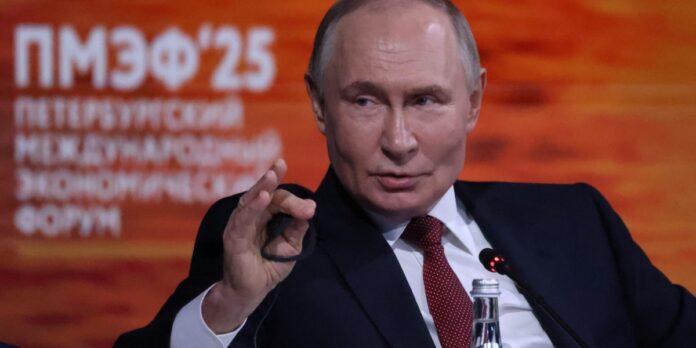Russia’s wartime economy, once defiant in the face of Western sanctions and geopolitical isolation, is showing signs of fatigue. On Thursday, Russia’s economy minister Maxim Reshetnikov warned the country was “on the brink” of a recession at the St. Petersburg Economic Forum.
Reshetnikov’s declaration confirmed what several economists foresaw earlier this year: Russia’s high-spending war economy, after years of defying predictions of imminent recession, is finally running into the hard limits of labor, productivity, and inflation.
Russia’s 2022 invasion of Ukraine prompted a slew of sanctions by Western nations, and the near-total departure of Western companies from the nation. But despite predictions of its imminent demise, the country’s economy has held up fairly well by pursuing what economists call “military Keynesianism,” fueling growth through massive defense-related fiscal spending. By pouring a record number of resources into the military-industrial complex, which reached a value of $167 billion last year, the Kremlin spiked industrial production, drove two consecutive years of GDP growth, and lifted wages across war-related sectors.
For decades, the Kremlin has allowed Russia’s defense budget to grow faster than the country’s GDP, but the budget expenditures have increased enormously since the start of Russia’s invasion of Ukraine. In 2021, the country spent 3.6% of its GDP on national defense, according to the World Bank. Now, 6.3% of the GDP goes to defense spending, nearly double the share in the United States.
Russia’s military spending bubble has created what Elina Ribakova, economist at the Peterson Institute for International Economics describes as a game of musical chairs.
“Everybody’s making money. Suddenly, people are enjoying higher incomes, and can get a mortgage, or buy durables. It makes this war popular in a practical, morbid way. You want the music going,” she explains.
But, as Nicholas Fenton, associate director at the Center for Strategic and International Studies warns, “You can only kind of spend so much before you hit structural limits in the economy. And the big hang up for the Russian economy throughout this period has been the country’s chronic labor shortage.”
Prior to Russia’s invasion of Ukraine, the country reported 4.75% unemployment in 2021, with levels hitting a record 2.4% low in early 2025, according to state-reported data. But as unemployment has declined, the country has also witnessed a mass exodus of as many as one million residents, and has suffered significant military deaths in the hundreds of thousands. These figures have exacerbated a pre-existing worker deficit in Russia due to a declining working-age population. In 2022 alone, the number of workers aged 16 to 35 fell by 1.33 million, and their share of the labor force was the lowest on record since 1996.
These preexisting shortages in the labor market have compounded as citizens were drafted, emigrated, or flocked to defense-related jobs with lucrative bonuses. Although real wages increased, productivity didn’t, fueling inflation and the threat of stagflation outside of the military, and stifling investments in non-defense sectors.
This spring, Russia’s manufacturing sector, an industry that also includes defense enterprises, suffered its steepest downturn in close to three years, dropping 2 points from February to March. Similarly, Russia’s industrial production growth hit a two-year low, increasing only 0.2% year-on-year.
All the while prices have continued to increase, growing by 9.52% last year compared to 7.42% in 2023. Currently, inflation in Russia sits at nearly 10% and the central bank’s hawkish stance has interest rates up to 20% in June. Meanwhile, the central bank’s growth forecast is between 1 and 2% for 2025.
Interest rates may be shifting, however: senior officials and Russian businessmen have repeatedly called for cuts to promote growth, and President Vladimir Putin has urged policymakers to strike a balance between fighting inflation and boosting growth.
Ultimately, for the country’s growth potential to change, the country would need to improve labor productivity, a difficult feat amid persisting sanctions and significant inflation, according to Alexander Kolyandr, senior fellow at the Center for European Policy Analysis.
On a per-capita basis, the nation’s GDP lags far behind peers, closer to that of Mexico or Turkey than Western Europe. And unlike Germany or Japan, Russia’s growth is heavily dependent on volatile commodity exports, such as oil, and state-driven demand.
Oil and gas revenues which account for around 20% of the country’s GDP, underscoring the precarious nature of its fiscal health. In the first half of 2025, falling oil exports and a dip in global prices forced the Kremlin to revise its budget deficit. But the growing conflict between Israel and Iran has already pushed oil prices higher, offering Russia potential temporary budgetary relief.
“The war in the Middle East is actually pretty good for Putin, but that wouldn’t save the economy. It just means that the government may continue to maintain this policy of managed decline,” Kolyandr tells Fortune.
Ribakova agrees with Kolyandr. “We were sort of rubbing our hands as oil was going down because that’s the most effective sanction against Russia. And of course, now we’ve seen the prices pick up,” she says.
Russia’s oil exports, however, don’t provide a solution to the lack of foreign investments in the country and the total retreat of American companies. Even with President Donald Trump’s hands-off approach to diplomacy with the Kremlin, Charles Kupchan, senior fellow at the Council on Foreign Relations, sees the return of U.S. businesses to Russia as a key bargaining chip.
“Trump is saying to Vladimir Putin, ‘if you’re ready to make a deal and end this war and agree to a ceasefire in place, I can envisage a return of American companies to Russia. I can envisage the rehabilitation of Vladimir Putin,’” he says.


